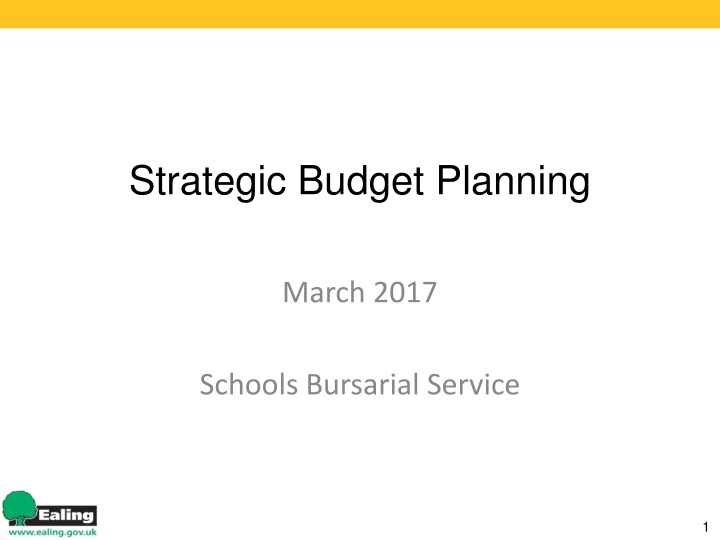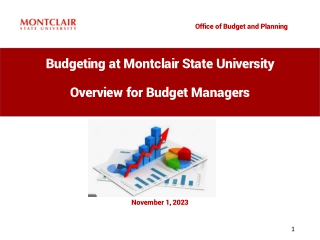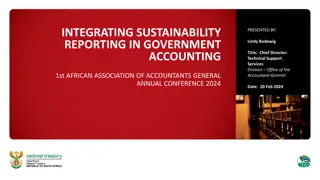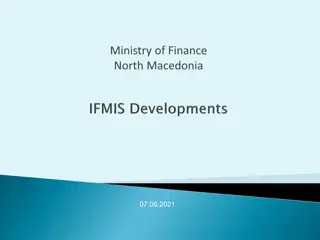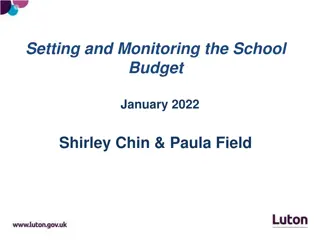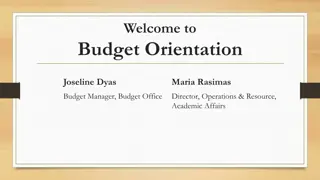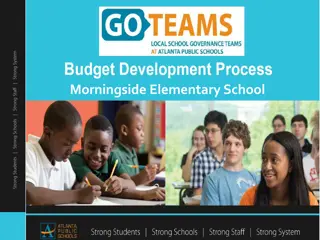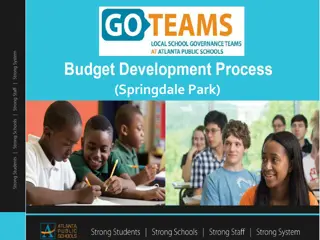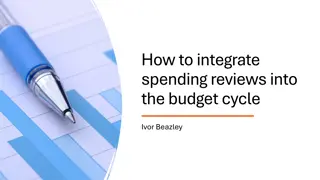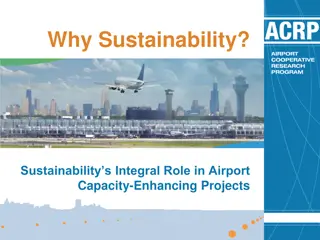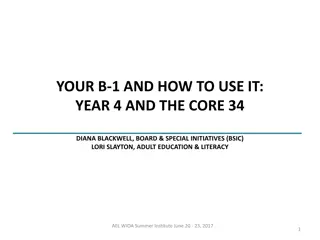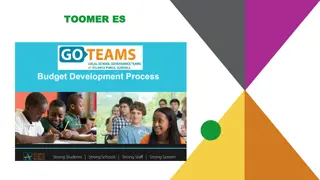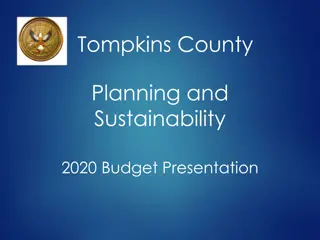Strategic Budget Planning for School Financial Sustainability
This comprehensive guide covers topics such as creating a budget strategy document, forecasting income and expenditure, understanding financial responsibilities, and developing sustainable budget plans for schools. The content includes workshop sessions, agenda details, timelines for budget setting, roles and responsibilities, and key risk factors affecting school finances. It emphasizes the importance of strategic planning and financial management in ensuring the long-term sustainability of school budgets.
Download Presentation

Please find below an Image/Link to download the presentation.
The content on the website is provided AS IS for your information and personal use only. It may not be sold, licensed, or shared on other websites without obtaining consent from the author.If you encounter any issues during the download, it is possible that the publisher has removed the file from their server.
You are allowed to download the files provided on this website for personal or commercial use, subject to the condition that they are used lawfully. All files are the property of their respective owners.
The content on the website is provided AS IS for your information and personal use only. It may not be sold, licensed, or shared on other websites without obtaining consent from the author.
E N D
Presentation Transcript
Strategic Budget Planning March 2017 Schools Bursarial Service 1
Intros Who are you? What role do you have? What would you like to get out of the session? 2
Workshop sessions Creating or developing a Budget Strategy Approaches schools may wish to take to develop a budget strategy document and 3 year forecast. Recovery planning Planning/forecasting income and expenditure Confidential, time to reflect and consider next steps. 3
Agenda Budget Strategy 9:15 10:30 Context and responsibilities Budget Strategy Document and 3 year planning Recovery planning Income 10:45 11:45 Schools Block High Needs Early Years PPG and other income Expenditure 12:00 12.45 Q&A 12.45 to close. 4
Timescales Budget setting for 17/18 first Friday in May All schools expected to have minimum of 3 year budget plan as best practice from 17/18 End of Summer 2017. 3 year plan submission to the LA only where a school believes they cannot manage any future pressures i.e. will be in deficit, or require a loan. Or have a surplus above BML 3 year plan should link to a budget strategy document 5
What do you, your schools SLT and governors know about Current financial position? Medium term financial position? Risks to budget sustainability? Roles and responsibilities? 7
Roles and Responsibilities LA - Scheme for Financing Schools - Ensure Schools and the LA operate within the finance regulations School and Governors - Effective Financial Management - Operate within the scheme, including submission of financial information - Sustainable budget planning 8
Wider Context The risk factors for each school varies: National Funding changes - EY, HN, SB Rising costs Curriculum Changing demography Changing responsibilities Many schools and heads experiencing greater financial difficulty 9
Budget Strategy and the Budget Strategy Document 10
Key elements of a Budget Strategy Summary Budget Strategy Document Link Schools Development Plan, Staffing, and Performance to Finance and Resources Medium to long term 3 to 5 year planning and modelling - Income and funding - Expenditure Recovery planning Reporting and engagement with governors 10
Budget Strategy Document and 3 year plan Schools position as a whole in income and expenditure planning will dictate level of detail required and prioritisation: No fixed format Evolving process National funding changes Guidance and support through: Estimate guidance notes Workshops Networking groups Online resources Bursarial services 11
Budget Strategy Document aims and content Aims Content High level summary with a broad set of scenarios: Contextual information, such as historic and current position financial and non financial School Development Plan objectives Summaries scenarios and the impact, what action the school would need to take Record the assumptions, approach and process taken Benchmarking Share with SLT and Governors Agree most likely scenario Agree actions and next steps Keep under review as a live document Raise awareness Open discussion Agree actions and next steps 13
Strategic Planning Broad set of assumptions refined and prioritised over time Scenario planning, small number of models largely based on: - Income, pupil characteristics and NOR. - Expenditure - staffing Reporting to Governors 14
Risks based approach SDP and financial Prioritisation Identify what the main risks are Internal and external risks Materiality and likelihood What are the drivers How much is controllable 15
Recovery plan What is a recovery plan? Planning and prevention Short to medium term Quick wins, and longer term planning Difficult decisions Value for money and outcomes based commissioning (Staff and Supplies and Services) Prioritising resources Covers income and expenditure 17
Recovery plan - Staffing SLT Span of control Consolidation of posts Class cover Teachers and Learning support staff Recruitment and retention Ratios Use of agency Contribution to T&L objectives Grades and deployment Other duties e.g. SMSA Back office and other staff Alliances and Buyback Redundancy 18
Recovery Plan Non staffing Non essential spend Contracts Procurement Stock Delivery models Asset management Invest to save 19
Recovery plan format Feeds directly into the Budget Strategy Document Determined by schools position Different reporting to different levels Working papers and scenario planning Governors Briefing note Narrative High level financial info Clear on risks, assumptions, options, any decision making Agree next steps, and any proposals and recommendations 20
Loans and Licenced Deficits Requires approval from the LA s Chief Finance Officer: Applications Timing Governor engagement Ongoing support 21
LA review and approval Summary of the recovery plan which includes an analysis of how the school: - Arrived at a deficit position - Is making the savings between years, - Has included some budget built in to manage the risk of staff absence, and other unexpected costs - Will repay the loan or deficit - Can manage the repayment over the period in terms of staffing levels and a sustainable budget 22
Info to support an application At account code level in excel format Prior Year Outturn Current Year and each year of deficit and repayment Budget (and forecasted budgets) Actuals to the end of most recent period Forecast expenditure and income Staffing and agency - detail forecast which would include payroll staff list with corresponding actuals and forecasts. Cash flow forecast showing the need for full cash payment of the loan upfront, and the ability to make repayments as proposed 23
Additional considerations Ofsted Academy conversion Withdrawal of delegation LA conditions on loans and deficits 24
Income 25
DSG - Schools Block Stage 2 consultation closes 22-3-2017 Scenario plan for the main variables: Number on Roll National Funding Formula Consider pupil characteristics Areas of change 2019/20 Growth Fund, Mobility, Rates 26
Modelling Pupil Numbers Historic Actuals Historic actuals and trends are a good indication of the future Up to and including 2017/18 funding ARP is deducted and funded through 10k place led. From 2018/19 this is through NFF plus 6k place led. Census Date Oct-14 Oct-15 Oct-16 Oct-17 Oct-18 Financial Year 2015/16 2016/17 2017/18 2018/19 2019/20 Mainstream 925.00 960.00 1,054.00 1050.00 1050.00 ARP: 0 0 0 0 0 Total Number on Roll 925.00 960.00 1,054.00 1050.00 1050.00 27
Modelling Pupil Numbers Scenarios A sustainable school with consistent NOR across year groups should be relatively straightforward Consider mobility, leavers (Y6 or Y11), entrants (R or Y7). External and internal risk factors Schools data team can assist where a school is in a particularly complex situation Agree and select a most likely and record the rational, Census Date Oct-17 Oct-18 Financial Year 2018/19 2019/20 Low 950.00 950.00 Medium 1050.00 1050.00 High* 1100.00 1100.00 Most Likely 1050.00 1050.00 28
National Funding Formula Pupil Led Look at the NFF illustrative allocations on Collect Model Gains and Losses MFG is 1.5% 2018/19, 1.5% 2019/20 Max gains 3% 2018/19, 2.5% 2019/20 Example Gainer: Example Loser: NFF to Baseline Variance NFF to Baseline Variance 7.36% -5.45% 2018/19 Gain/Loss Variance to formula 2019/20 Gain/Loss Variance to formula 3.00% 4.36% 2.50% 1.86% 2018/19 Gain/Loss Variance to formula 2019/20 Gain/Loss Variance to formula -1.50% -3.95% -1.50% -2.45% 29
Per Pupil Funding Apply the NFF caps and losses to the existing per pupil led funding. Excluding school led elements Multiply this by the NOR estimates Scenarios 2018/19 2019/20 Comments Prudent estimate of Low would be -1.5% unless these is a justifiable reason this should be less. Low Medium -1.50% 0.00% -1.50% 0.00% Prudent estimate of high would be 0% unless these is a justifiable reason this should be more Describe what these assumptions are based on High 3.00% -1.50% 2.50% -1.50% Most likely 30
Rationalise the Scenarios Agree what the most likely scenario is Select scenarios where necessary Model the impact Add school led elements, rates, lump sum, split sites, mobility Deduct dedelegation, education functions, schools improvement Pupil Led Funding Medium 2018/19 Low Scenario High NOR Low Medium High 1 4 7 2 5 8 3 6 9 31
DSG - High Needs NFF - Funding to the LA is cash flat with considerable growth in demand anticipated over the coming years. SEN Support Fund - Agreed year on year High Needs Mainstream - Agreed at a child level - Numerous approaches depending on school s situation. e.g. Historic income, in and out of income and exp, child level forecasts. High Needs ARP and Special Place led funding, commissioning agreements with Ealing Ealing Top Up values Non Ealing Top Up values Exceptional funding Vacancies and over numbers 32
DSG - Early Years New EYSFF in Ealing Changes to the Early Years Single Funding Formula uniform base rate regardless of sector. Maintained Nursery Classes will see a increase Nursery Schools are financially protected outside the formula. All provider base rate of 4.64 (a raise from 3.27) with supplementary funding of 0.26 for QTS led classes (reduction from 0.70). Per 15 hours per annum 2263 v 2793 Introduction of 30 hour entitlement 33
Calculating EY Funding Estimate the termly NOR Look at historic data Estimate starters after headcount Other factors: competition, quality, marketing. Consider impact on Reception intake Make a judgement on the funding rates Record your assumptions Scenarios Consider impact on expenditure, ratios and the impact of tipping just over. New additional 15 hours is at the same rate 34
Calculating EY Funding 2016/17 2017/18 OUTTURN FORECAST No. of pupils 2016 Numbers Funding 2018/19 FORECAST BUDGET 2019/20 FORECAST BUDGET 2015/16 No. of funding weeks No. of pupils 2015 Pupil Pupil Numbers Funding Pupil Numbers Funding Summer Count Starters after Summer Count Autumn Count Starter after Autumn Count 12 52 45,864 52 45,864 52 45,864 52 52 6 0 - 0 - 0 - 1 1 14 32 32,928 32 32,928 32 32,928 32 32 7 0 - 0 - 0 - 0 0 Spring Count Starters after Spring Count 12 46 40,572 46 40,572 46 40,572 51 46 6 0 - 0 - 0 - 3 3 Sub Total Deprivation factor* p/h Total EYSFF Funding Universal Entitlement 119,364 119,364 119,364 0.26 - - - 119,364 119,364 119,364 35
Impact of 30 hour entitlement Parent Demand Survey - 71.3% of parents said they would switch provider to use full 30 hours if their current provider could only deliver 15 hours. Possible implications if 30hrs is not offered; Possible drop in current nursery children on roll This could in turn have a knock-on effect to future years, reception intake Financial implications of not being at capacity Parental dissatisfaction If the 30 hours are offered Long term stability Better outcomes for children Transition into school Block places 36
EY 30 hours next steps Undertake a local parental demand survey (a template is available) Consider impact on income and expenditure Consider opportunities for additional fee income How many full time places to offer? Create a business case Use EGFL to access information https://www.egfl.org.uk/topics/early-years/business-and-finance-early- years 37
PPG Focus on Deprivation PPG Government commitment for this parliament Methods used to estimate deprivation PPG: Calculating FSM6 estimates Making more general assumptions about % increase and decreases over time Applying local knowledge Estimate guidance notes 2017/18 Should be linked to Schools block NOR estimates PPG assumptions then relate to the proportion of NOR Guidance note on EGFL: https://www.egfl.org.uk/sites/default/files/Finance_data/Budgets/Pupil% 20Premium%20Grant%20-%20guidance%20note%20v2.pdf Other PPG 38
Post 16 Lagged Funding Funded on Academic year DfE tools https://www.gov.uk/government/publications/post-16- funding-allocations-supporting-documents-for-2017-to- 2018 Consider: Historic numbers Curriculum offer Cash flow and expenditure issues from lagged funding 40
Other Income Sports Premium - Funding has been confirmed as doubled, there is no current commitment beyond 2017/18 UIFSM - Funding for UFISM is a government commitment for this parliament, therefore should be in place until 2019/20. Year 7 catch up - LA will receive your funding for the 2016 to 2017 academic year on 28 February 2017. There is no funding commitment confirmed beyond 2016/17 (All funded on the academic year) Other - lettings, fees, training, catering, etc. 41
Expenditure 42
Resources and tools DfE - School financial health and efficiency https://www.gov.uk/government/collections/schools-financial-health-and-efficiency DfE - Self Assessment tools https://www.gov.uk/guidance/making-the-most-of-financial-review-and-self- assessment-tools DfE - Benchmarking https://www.gov.uk/guidance/schools-financial-efficiency-financial-benchmarking Other schools and networking groups Guidance for academies Innovations from other sectors 43
Areas to consider Benchmarking Staffing and Payroll Supplies and services Asset management Modelling 44
Benchmarking Platform to promote discussion Challenge Context Top 10 planning checks for governors (per DfE): 1. Staff pay as percentage of total expenditure 2. Average teacher cost 3. Pupil to teacher ratio (PTR) 4. Class sizes 5. Teacher contact ratio 6. Proportion of budget spent on the leadership team 7. 3 to 5 year budget projections 8. Spend per pupil for non-pay expenditure lines compared to similar schools 9. School improvement plan priorities and the relative cost of options 10. List of contracts with costs and renewal dates 45
Staffing and Payroll National insurance Pensions Pay award Increments and TLR Structures Use of agency and temporary staff Curriculum Planning https://www.gov.uk/government/publications/school-workforce-planning https://www.gov.uk/guidance/schools-financial-efficiency-benefits-of- workforce-planning Prioritising staffing to meet SDP Implementation of new initiatives Affordability and ratios Alliances In-house v Outsourcing 46
Supplies and services Contract terms and renewal Buyer power Inflation and efficiencies Invest to save Estimate level of demand Outcomes based commissioning Joint procurement and collaboration https://www.gov.uk/guidance/buying-for-schools 47
Asset management Factor in future costs Maintenance Replacement Condition funding Invest to save Energy efficiency Income generation Ordering and stock levels Efficiency Planning Contracting 48
Modelling Expenditure levels are largely dependent on the income modelling Create a baseline and then select alternative scenarios Summarise each and their likely impact 49
